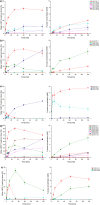Improved Enzymatic Production of the Fucosylated Human Milk Oligosaccharide LNFP II with GH29B α-1,3/4-l-Fucosidases
- PMID: 38691641
- PMCID: PMC11100010
- DOI: 10.1021/acs.jafc.4c01547
Improved Enzymatic Production of the Fucosylated Human Milk Oligosaccharide LNFP II with GH29B α-1,3/4-l-Fucosidases
Erratum in
-
Correction to "Improved Enzymatic Production of the Fucosylated Human Milk Oligosaccharide LNFP II with GH29B α-1,3/4-L-Fucosidases".J Agric Food Chem. 2024 Jun 26;72(25):14480. doi: 10.1021/acs.jafc.4c04966. Epub 2024 Jun 14. J Agric Food Chem. 2024. PMID: 38876976 Free PMC article. No abstract available.
Abstract
Five GH29B α-1,3/4-l-fucosidases (EC 3.2.1.111) were investigated for their ability to catalyze the formation of the human milk oligosaccharide lacto-N-fucopentaose II (LNFP II) from lacto-N-tetraose (LNT) and 3-fucosyllactose (3FL) via transglycosylation. We studied the effect of pH on transfucosylation and hydrolysis and explored the impact of specific mutations using molecular dynamics simulations. LNFP II yields of 91 and 65% were obtained for the wild-type SpGH29C and CpAfc2 enzymes, respectively, being the highest LNFP II transglycosylation yields reported to date. BbAfcB and BiAfcB are highly hydrolytic enzymes. The results indicate that the effects of pH and buffer systems are enzyme-dependent yet relevant to consider when designing transglycosylation reactions. Replacing Thr284 in BiAfcB with Val resulted in increased transglycosylation yields, while the opposite replacement of Val258 in SpGH29C and Val289 CpAfc2 with Thr decreased the transfucosylation, confirming a role of Thr and Val in controlling the flexibility of the acid/base loop in the enzymes, which in turn affects transglycosylation. The substitution of an Ala residue with His almost abolished secondary hydrolysis in CpAfc2 and BbAfcB. The results are directly applicable in the enhancement of transglycosylation and may have significant implications for manufacturing of LNFP II as a new infant formula ingredient.
Keywords: acid/base residue flexibility; molecular dynamics; protein engineering; transglycosylation.
Conflict of interest statement
The authors declare no competing financial interest.
Figures





Similar articles
-
Loop engineering of an α-1,3/4-l-fucosidase for improved synthesis of human milk oligosaccharides.Enzyme Microb Technol. 2018 Aug;115:37-44. doi: 10.1016/j.enzmictec.2018.04.008. Epub 2018 Apr 23. Enzyme Microb Technol. 2018. PMID: 29859601
-
Substrate specificity and transfucosylation activity of GH29 α-l-fucosidases for enzymatic production of human milk oligosaccharides.N Biotechnol. 2018 Mar 25;41:34-45. doi: 10.1016/j.nbt.2017.12.002. Epub 2017 Dec 6. N Biotechnol. 2018. PMID: 29221760
-
Infant Gut Microbial Metagenome Mining of α-l-Fucosidases with Activity on Fucosylated Human Milk Oligosaccharides and Glycoconjugates.Microbiol Spectr. 2022 Aug 31;10(4):e0177522. doi: 10.1128/spectrum.01775-22. Epub 2022 Aug 9. Microbiol Spectr. 2022. PMID: 35943155 Free PMC article.
-
Enzymatic transfucosylation for synthesis of human milk oligosaccharides.Carbohydr Res. 2020 Jul;493:108029. doi: 10.1016/j.carres.2020.108029. Epub 2020 May 8. Carbohydr Res. 2020. PMID: 32445980 Review.
-
α-L-Fucosidases and their applications for the production of fucosylated human milk oligosaccharides.Appl Microbiol Biotechnol. 2020 Jul;104(13):5619-5631. doi: 10.1007/s00253-020-10635-7. Epub 2020 May 1. Appl Microbiol Biotechnol. 2020. PMID: 32356197 Review.
Cited by
-
Recent advances in the science of human milk oligosaccharides.BBA Adv. 2025 Jan 24;7:100136. doi: 10.1016/j.bbadva.2024.100136. eCollection 2025. BBA Adv. 2025. PMID: 39991261 Free PMC article.
-
Structural elucidation and characterization of GH29A α-l-fucosidases and the effect of pH on their transglycosylation.FEBS J. 2025 Feb;292(3):653-680. doi: 10.1111/febs.17347. Epub 2024 Dec 10. FEBS J. 2025. PMID: 39658312 Free PMC article.
-
Purification and immobilization of β-glucosidase using surface modified mesoporous silica Santa Barbara Amorphous 15 for eco-friendly preparation of sagittatoside A.Nat Prod Bioprospect. 2024 Aug 23;14(1):50. doi: 10.1007/s13659-024-00471-x. Nat Prod Bioprospect. 2024. PMID: 39177672 Free PMC article.
References
MeSH terms
LinkOut - more resources
Full Text Sources

